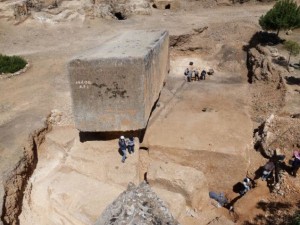World’s Largest Ancient Stone Block Is Found
German archaeologists working at the Baalbek site in Lebanon have exposed the largest known ancient block.
The fully uncovered block, which dates back to around 27 B.C., is the well known Hajjar al-Hibla. It’s placed in a stone quarry at Baalbek, site of the first Heliopolis in Lebanon. Similar stone blocks measuring up to 20 meters (65 feet) in length and a diameter of 4 x 4 meters (13 x 13 feet) were used for the platform of the huge Temple of Jupiter in the Roman sanctuary of Baalbek.
Archeologists previously determined that Hajjar-al-Hibla was probably left in the quarry because its edges had low-quality stone that might get damaged during transport. Further excavations will try to determine whether the bigger stone block suffered the same fate.It was presumably cut for use in a Roman temple—before ancient builders determined that it wasn’t up to snuff.
A few months before, a team from the German Archaeological Institute conducted excavations at the dig, and to their astonishment they found an ever bigger stone just off to the side and underneath it. It measures 19.6 meters (64 feet) in length, 6 meters (19.6 feet) wide, and is at least 5.5 meters (18 feet) high. Its weight is predictable at a daunting 1,650 tons (that’s 3,300,000 pounds or 1,496,850 kg). Future excavations will prove its exact dimensions.
The archaeologists concluded that because of the stone’s design and level of smoothness, the block was meant to be transported exclusive of being cut. It’s thus the biggest stone block known from remains. They’re now investigating why the stone was not done and remained in the quarry and by what means the Roman builders had to transport it.
